INTRODUCTION
Nearly every place on Earth contains bacteria, including the human body. Bacteria are found on the skin, nose, mouth, throat, vagina, and gut. Some bacteria are pathogenetic. Numerous mechanisms are used by pathogenic bacteria to wreak harm on human hosts (Wilson, 2002). One of the immunological defenses against bacterial infection is formed by human skin. Numerous bacteria can come into contact with or settle on the skin (Aljamali et al., 2021). They typically wait until the skin is damaged before getting access to the underlying tissue (Sharma et al., 2021). The condition of infection and the ability of bacteria to replicate depend on whether the skin damage is classified as inflamed, colonized, localized/critically colonized, or invasively spread (Sharma et al., 2021). When bacterial skin infections do arise, they can affect any part of the body, either a small patch or the full surface. They may be mild or potentially fatal, depending on their severity (Ki and Rotstein, 2008).
Natural compounds with antibacterial activity can be thought of as possible natural antibiotics (Pancu et al., 2021). Many natural compounds have been reported to have antibacterial activity (Tafroji et al., 2022), for example, Centella asiatica (Chauhan et al., 2009; Nasution et al., 2018; Restuati and Diningrat, 2018). Common names for C. asiatica include Asiatic pennywort and Gotu kola (Shukurova et al., 2021). It is a member of Umbelliferae family (Apiaceae) (Gohil et al., 2010; Shukurova et al., 2021) and a native plant from Southeast Asia (Chandrika and Prasad Kumara, 2015; Orhan, 2012). Phytosterols, triterpenoid saponins, genin triterpenoids, essential oils, and flavonoids are only a few of C. asiatica active components (Irham et al., 2019).
Tracking literature for a pertinent topic has been challenging for researchers due to the recent rapid growth in the volume of research work. Therefore, bibliometric analysis methods were used to handle this vast amount of data (Zupic and ?ater, 2015). A bibliometric study is usually used to assess the quality and quantity of published papers in order to identify trends in a given topic of study (Zuraidi et al., 2022). Large amounts of scientific data were investigated and analyzed by using bibliometric software, such as Visualization of Similarities viewer (VOSviewer), and scientific databases, such as Scopus (Donthu et al., 2021). A bibliometric study had been conducted using Derwent Data Analyzer to investigate papers on the subject of antibiotic-resistant bacteria that were obtained from the Web of Science between 2010 and 2020 (Sun et al., 2022). In the other studies, VOSviewer was used to determine the top 100 articles on the subject of antibiotics that were gathered from the Web of Science (Arshad et al., 2020). In this study, bibliometric analysis was conducted to explore papers related to the antibacterial activity of C. asiatica in order to help other researchers in finding prospects for future study, prospects for collaboration with other institutions or authors, and impacted journals for publication of any study on this topic.
MATERIALS AND METHODS
Data collection
Published papers about C. asiatica as an antibacterial agent were collected from Scopus database on November 10, 2022. Scopus database was chosen because it is a more thorough and larger database than the Web of Science, and it is beneficial both in keyword searching and citation analysis (Bamel et al., 2020; Effendi et al., 2021; Falagas et al., 2008). Google Scholar was not used since its poor data quality raises concerns about its usefulness for research evaluation (Mongeon and Paul-Hus, 2016). Data collection was performed by the following search: [TITLE-ABS-KEY (“Centella asiatica”) AND TITLE-ABS-KEY (antibacteria*) OR TITLE-ABS-KEY (antimicrobia*)]. The double quotation marks indicate a loose or approximate phrase. The asterisk or star-shaped symbol stands for any combination of characters in Scopus data syntax (Ha et al., 2020). The search was limited to title, abstract, and keywords. The range of years was not determined.
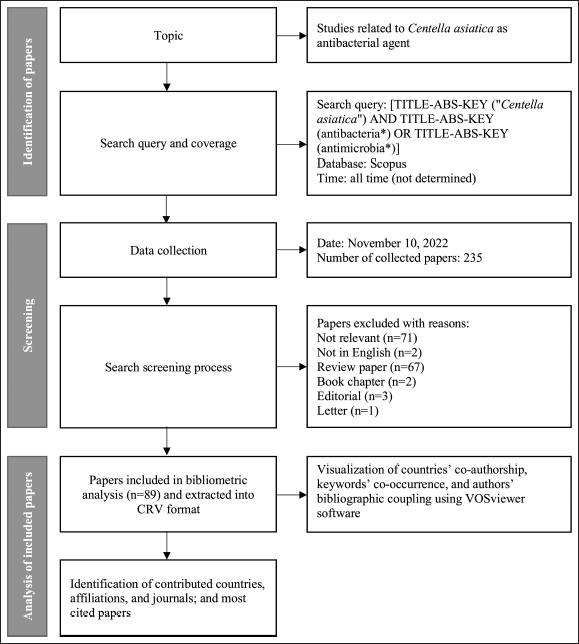 | Figure 1. Flowchart of study methodology. [Click here to view] |
Data screening, extraction, and analysis
Only published papers that met the inclusion criteria would be analyzed. Original articles, conference papers, writing in English, and a study of the antibacterial activity of C. asiatica were among the inclusion criteria. Figure 1 provides a summary of the record-gathering and study-elimination procedure. For further analysis, the selected papers were extracted into CRV format (file.crv) and exported to VOSviewer version 1.6.18 as a bibliometric tool (Ha et al., 2020). Countries’ co-authorship, keywords’ co-occurrence, and authors’ bibliographic coupling were presented as network visualization maps. The items (countries, keywords, and authors) were visualized as a bubble. The size of the bubble is reflected by the weight of each item (van Eck and Waltman, 2022; Yeung et al., 2020), which is proportional (Romero and Portillo-Salido, 2019). The color of the bubble describes the cluster where the item belongs. Bubbles are connected by lines that represent links. The distance between the two bubbles represents the relatedness of co-authorship, co-occurrence, and bibliographic coupling between the items (Romero and Portillo-Salido, 2019). The full counting method was used in this study.
RESULTS
Publication trends
Among 235 of the collected published papers related to the antibacterial activity of C. asiatica, only 89 papers met the inclusion criteria (Table 1). All selected papers included 72 journals and 376 authors. The oldest paper was published in 1997 by Fitoterapia entitled “Antibacterial activity of Centella asiatica” (Srivastava et al., 1997). The most recent paper was published in 2022 by the Research Journal of Pharmacognosy about the antimicrobial properties of C. asiatica and other plant extracts against Staphylococcus aureus, Pseudomonas aeruginosa, Acinetobacter baumannii, and methicillin-resistant S. aureus (Tavakoli et al., 2022).
The number of publications on the topic of antibacterial activity of C. asiatica fluctuated over the years (Fig. 2). Between 1998 and 2002, and in 2013, there was no published paper on this topic. In 2020, scientists were expected to become more interested in this topic based on the increasing number of papers. The largest number of publications occurred in 2021 with 12 papers.
 | Table 1. Selected papers from early to recent years. [Click here to view] |
Contribution by countries and their collaborations
Twenty-seven countries performed a research study on the antibacterial activity of C. asiatica in 89 papers that were selected for this study. The number of papers by the most productive country in the field of the topic is presented in Table 2. The countries in the Asia continent dominated the list. The most productive country was India with 36 papers. It means India has made a noteworthy contribution to this topic compared to the rest of the countries. The second-most productive country was Malaysia with 15 papers, followed by Indonesia and Thailand with 10 papers. Thailand came with the highest average number of citations (AC) among the most productive countries, followed by the United Kingdom.
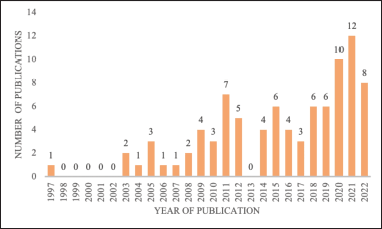 | Figure 2. Publication trends on the topic of antibacterial activity of C. asiatica. [Click here to view] |
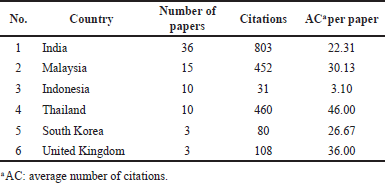 | Table 2. The most productive countries on the topic of antibacterial activity of C. asiatica. [Click here to view] |
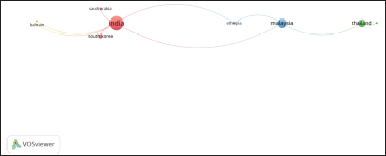 | Figure 3. The network visualization of co-authorship analysis of countries on the topic of antibacterial activity of C. asiatica. [Click here to view] |
The collaborations of countries were visualized using co-authorship analysis with countries as the unit of analysis on VOSviewer. The minimum number of papers and the minimum number of citations for a country were set at 1 and 0, respectively. The network visualization result of collaboration between countries that contributed to the research study on the antibacterial activity of C. asiatica is shown in Figure 3. Among 27 countries, the largest connected countries only consisted of nine: India, Saudi Arabia, South Korea, Australia, Thailand, Malaysia, Ethiopia, Bahrain, and Turkey. India had the greatest number of links, which was 6. Therefore, India came out as the country with the biggest collaboration. It collaborated with Saudi Arabia, South Korea, Malaysia, Ethiopia, Bahrain, and Turkey.
Contribution by affiliations
Based on the 89 selected papers, 160 affiliations provided a research study on the antibacterial activity of C. asiatica. Table 3 shows the most productive affiliations, with at least two papers published on the topic. The most productive affiliation was Ubon Ratchathani University, with three papers. Among the 16 affiliations on the list, India had 7 affiliations, Malaysia had 6 affiliations, Thailand had 2 affiliations, and South Korea had 1 affiliation. All of the countries with the most productive affiliations are on the Asian continent. The highest AC among the most productive affiliations was Universiti Sains Malaysia, with 57.50. It indicates that the papers produced by Universiti Sains Malaysia on this topic are more influential than those from Ubon Ratchathani University.
Contribution by journals
The 89 selected research papers on the antibacterial activity of C. asiatica were published in 72 journals. Ten of them published more than one paper. The top four journals with the most papers published on the topic are presented in Table 4. The most productive journal on this topic was the Journal of Ethnopharmacology from Elsevier Ireland Ltd. with 6 papers and AC 102.33 (the latest paper on the topic of the antibacterial activity of C. asiatica was published in 2022), followed by the International Journal of Phytomedicine, the Journal of Pure and Applied Microbiology, and the Pharmacognosy Journal, which published three papers. The African Journal of Biotechnology, the Asian Pacific Journal of Tropical Biomedicine, the Biomedical and Pharmacology Journal, the Journal of Food Processing and Preservation, Polymers, and In Chemistry Communications published two papers on the topic. This information will assist the scientists in seeking out a specific journal and submitting their reports of study on this topic to those journals (Arifah et al., 2021). The Journal of Ethnopharmacology can be considered a targeted journal for the publication of articles on the antibacterial activity of C. asiatica.
Analysis of authors and their bibliographical coupling network
Of the 89 selected papers, 376 authors contributed to the studies of the antibacterial activity of C. asiatica. Only 13 authors published more than 1 paper; the highest number of papers per author was 2. It indicated the number of researchers who focused on this topic was low.
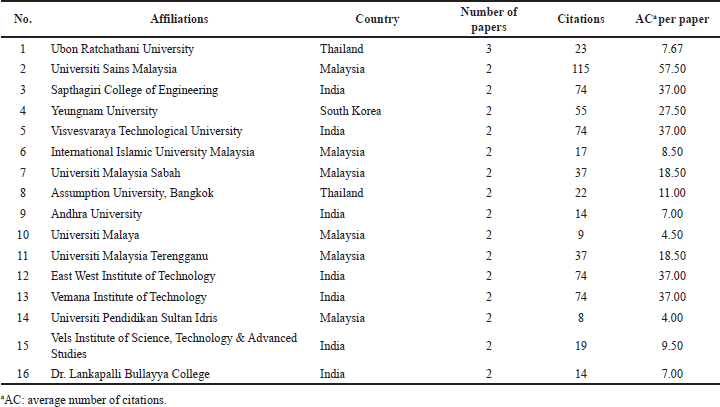 | Table 3. The most productive affiliations on the topic of antibacterial activity of C. asiatica. [Click here to view] |
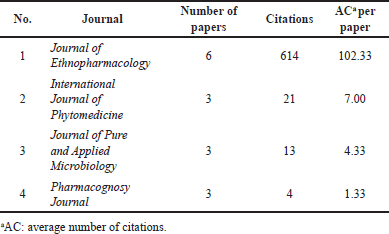 | Table 4. The most productive journals on the topic of antibacterial activity of C. asiatica. [Click here to view] |
The most productive authors are presented in Table 5. They were affiliated with colleges in India (6), Thailand (3), Indonesia (2), and Malaysia (2). This is connected to the Southeast Asian region, where C. asiatica originated (Chandrika and Prasad Kumara, 2015; Orhan, 2012). By knowing the author’s name, affiliation, and country of origin, other researchers interested in this topic can create and promote research collaboration (Arifah et al., 2021).
A bibliographical coupling of authors was performed to analyze the authors who published two papers that cited the same third paper (Perianes-Rodriguez et al., 2016) and stated in coupling strength (Ma et al., 2022). A higher coupling strength indicates more shared citations between the two papers (Ma et al., 2022). The minimum number of papers for an author was set to 2. Thirteen authors met the criterion, but the largest set of linked authors consisted of only 8 authors.
The outcome of the network visualization of bibliographical coupling based on the authors’ studies is shown in Figure 4. Three clusters were obtained. The clusters indicated that there was a relationship between the authors (Effendi et al., 2021). Clusters 1, 2, and 3 were represented with red, green, and blue nodes, respectively. Cluster 1 consisted of Diky Setya Diningrat, Martina Restuati, and Varahalarao Rao Vadlapudi. Cluster 2 consisted of Parichat Phumkhachorn, Pongsak Rattanachaikunsopon, and Patchanee Yasurin. Cluster 3 consisted of Suzita Ramli and Junxian Wong. Due to the fact that each author had two papers, the bubble sizes are all the same.
There were 17 links among the authors. Each link has a strength representing the number of cited references that the two papers share (van Eck and Waltman, 2022). Patchanee Yasurin has the greatest number of links, which are linked to Parichat Phumkhachorn, Pongsak Rattanachaikunsopon, Diky Setya Diningrat, Martina Restuati, Suzita Ramli, and Junxian Wong. It indicated that Patchanee Yasurin’s papers and those authors’ shared some cited references in common. His first paper investigated the impact of C. asiatica’s solvent extraction on its chemical composition and antibacterial activity against various microbial pathogens (Rattanakom and Yasurin, 2015). It was similar to his linked authors’ papers. The variants came from testing microorganisms, plant components, and solvent extractions (the brief of the study is presented in Table 5). Meanwhile, his second paper investigated the antibacterial activity of gelatin nanoparticles loaded with C. asiatica chloroform extract (Kesornbuakao et al., 2018).
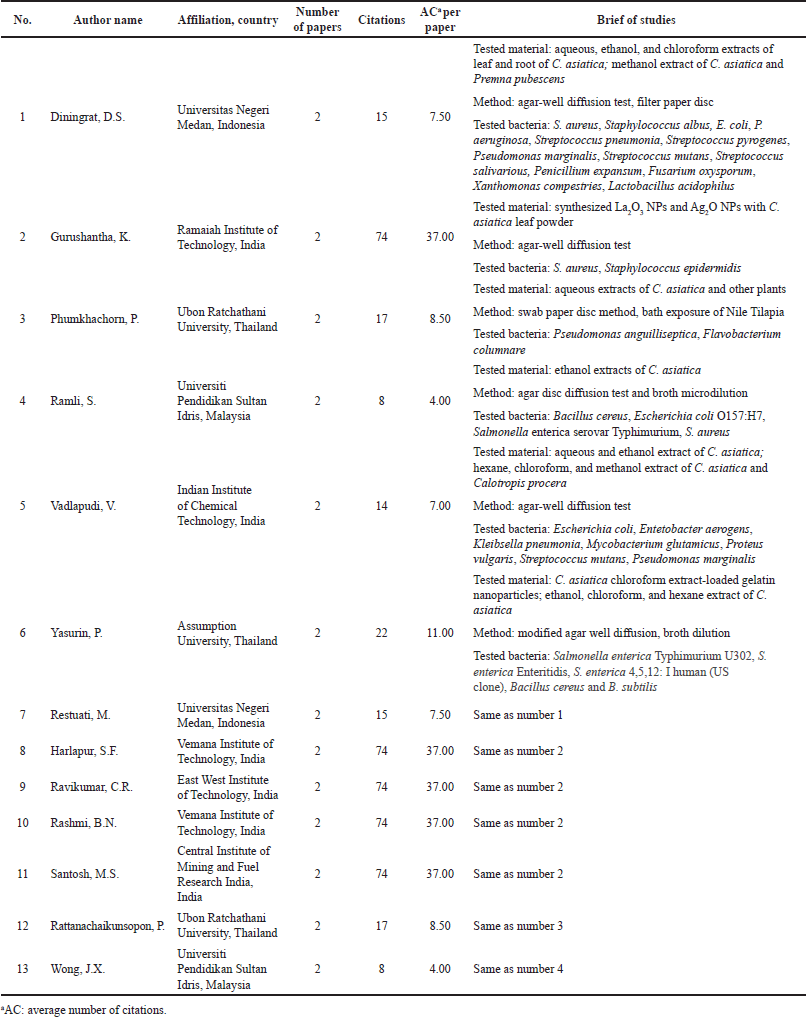 | Table 5. The most productive authors on the topic of antibacterial activity of C. asiatica. [Click here to view] |
Analysis of cited papers
The more the paper is cited, the higher its influence is on this topic. Among the 89 selected papers, 37 had been cited at least 10 times, and 5 had been cited at least 100 times. Table 6 shows the five most frequently cited papers, which have been cited more than 100 times. Logeswari’s team paper had the highest citation, having been cited 363 times. Their paper was published in the Journal of the Saudi Chemical Society in 2015 with the title “Synthesis of silver nanoparticles using plant extract and analysis of their antimicrobial properties.” They used the extracts of C. asiatica, Ocimum tenuiflorum, Solanum trilobatum, Syzygium cumini, and Citrus sinensis to synthesize silver nanoparticles and evaluated the antibacterial activity of the synthesized silver nanoparticles using the well diffusion method. Other top five cited papers were published earlier (before 2010), most of which were published in the Journal of Ethnopharmacology. It is in accordance with the results of the most productive journals.
Keyword co-occurrence network
The co-occurrence analysis of keywords was conducted to determine which one frequently occurred. It will help researchers spot the most popular topics and emerging trends in a field. In a paper, two words that cooccur quite often may have a stronger connection than other word pairs (Romero and Portillo-Salido, 2019). The author keyword was chosen as the unit of analysis. Of the 89 selected papers, there were 286 keywords provided by the authors. The minimum number of occurrences of a keyword was set at 2. Thirty-four keywords met the threshold, but only 32 keywords made up the largest set of linked keywords. Figure 5 shows the mapping of the co-occurrence analysis of these 32 connected keywords. “Centella asiatica” had the most links, with 21 links. The co-occurrence strength between two keywords is represented by the thickness of the link line and it is directly proportional (Feng and Chen, 2020). “Centella asiatica” had a thicker link with both “antibacterial” and “antimicrobial activity” than the other keywords that connected to “Centella asiatica.” It related to the searches performed on the data collection. The keyword “Centella asiatica” was also connected to “wound healing”, “antioxidant activity”, “antifungal”, and “antibiofilm”, which indicated other pharmacological activities of C. asiatica. It had also been investigated in several studies.
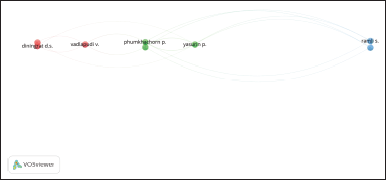 | Figure 4. The network visualization of bibliographic coupling of authors on the topic of antibacterial activity of C. asiatica. [Click here to view] |
The top seven keywords in selected papers on the topic of the antibacterial activity of C. asiatica were “Centella asiatica,” “antibacterial activity,” “antimicrobial activity,” “medicinal plants,” “antibacterial,” “antimicrobial,” and “antioxidant” (Table 7). In the early years, the terms such as “antimicrobial activity,” “apiaceae,” “disc diffusion,” and “plant extract” tended to appear frequently in author keywords. In contrast, “Staphylococcus aureus,” “wound healing,” “chitosan,” “cyclic voltammetry,” and “photocatalysis” appeared in recent years, indicating that they have been the current research hotspots.
The term “chitosan” was used in two papers that investigated the use of chitosan and C. asiatica in bilayer patches against Propionibacterium acnes (Kuo et al., 2021) and in hydrogel as a wound dressing (Wang et al., 2021). This showed that the recent research topic of the antibacterial activity of C. asiatica has included the formulation strategy. In view of the antibacterial activity of C. asiatica already explored in several solvent extractions (aqueous, ethanol, methanol, and chloroform) and bacteria (Nasution et al., 2018), the formulation strategy remains promising to be explored and followed by in vivo preclinical and clinical trials of the developed products. For example, the in vivo preclinical or clinical trial of developed products of wound dressing containing C. asiatica extract (either using aqueous, ethanol, methanol, chloroform, or other solvent extractions) for diabetes wounds or burns can be explored.
 | Table 6. Top five cited papers on the topic of antibacterial activity of C. asiatica. [Click here to view] |
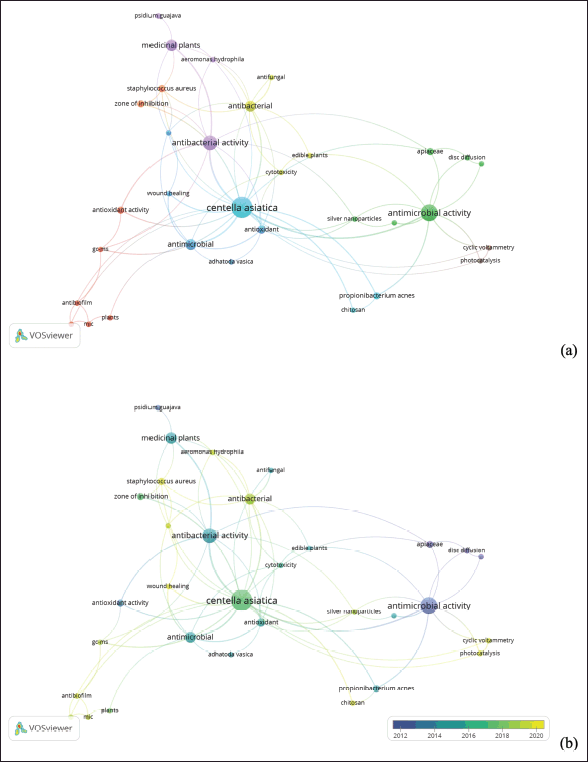 | Figure 5. The largest set of connected author keywords on the topic of antibacterial activity of C. asiatica. (a) The mapping of VOSviewer network visualization. (b) The mapping of VOSviewer overlay visualization. [Click here to view] |
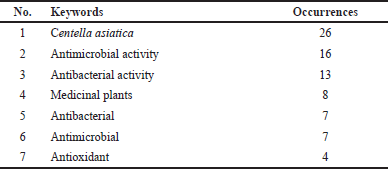 | Table 7. Top seven keywords with the highest frequency of occurrence. [Click here to view] |
CONCLUSION
This study found a fluctuating number of papers related to the topic between 1997 and 2022. General information about the papers was also provided, including the most productive country (India), the most collaborating country (India), the most productive affiliation (Ubon Ratchathani University), the most productive journal (Journal of Ethnopharmacology), the most cited paper (Synthesis of silver nanoparticles using plant extract and analysis of their antimicrobial properties by Logeswari et al. [2015]), and the most frequent keyword (“Centella asiatica”). Furthermore, information from the keyword co-occurrence network revealed that the formulation approach has been studied recently concerning the antibacterial activity of C. asiatica. The formulation strategy of C. asiatica as an antibacterial agent, followed by its in vivo preclinical and clinical trials, remains a promising study to be explored in order to adopt phytomedicine as a therapeutic option.
ACKNOWLEDGMENT
This study was funded by Universitas Muhammadiyah Surakarta through Hibah Integrasi Tri Dharma (HIT).
AUTHOR CONTRIBUTIONS
All authors made substantial contributions to the conception and design, acquisition of data, or analysis and interpretation of data; took part in drafting the article or revising it critically for important intellectual content; agreed to submit to the current journal; gave final approval of the version to be published; and agree to be accountable for all aspects of the work. All the authors are eligible to be an author as per the international committee of medical journal editors (ICMJE) requirements/guidelines.
CONFLICTS OF INTEREST
The authors report no financial or any other conflicts of interest in this work.
ETHICAL APPROVALS
This study does not involve experiments on animals or human subjects.
DATA AVAILABILITY
All data generated and analyzed are included in this research article.
PUBLISHER’S NOTE
This journal remains neutral with regard to jurisdictional claims in published institutional affiliation.
REFERENCES
Aljamali DNM, Al-zubaidy ZH, Enad AH. Bacterial infection and common bacterial diseases: a review. Trends Pharm, Nanotechnol MAT J, 2021; 3(2):13–22.
Al-Talib H, Ali NDM, Suhaimi MH, Rosli SSN, Othman NH, Mansor NAS, Shah AK, Ariffin NS, Al-Khateeb A. Antimicrobial effect of Malaysian vegetables against enteric bacteria. Asian Pac J Trop Biomed, 2016; 6(3):211–5; https://doi.org/10.1016/j.apjtb.2015.12.009
Amornopparattanakul N, Waranuch N, Lamlertthon S, Wisuitiprot W, Ingkaninan K. Development of oral cleansing products containing green tea and Centella asiatica extracts. KEM, 2021; 907:48–54; https://doi.org/10.4028/www.scientific.net/KEM.901.48
Arifah FH, Nugroho AE, Rohman A, Sujarwo W. A bibliometric analysis of preclinical trials of Andrographis paniculata (Burm.f.) Nees in diabetes mellitus. S Afr J Bot, 2021; 151:128–43; https://doi.org/10.1016/j.sajb.2021.12.011
Arshad AI, Ahmad P, Karobari MI, Asif JA, Alam MK, Mahmood Z, Abd Rahman N, Mamat N, Kamal MA. Antibiotics: a bibliometric analysis of top 100 classics. Antibiotics, 2020; 9(5):219; https://doi.org/10.3390/antibiotics9050219
Arumugam T, Ayyanar M, Koil Pillai YJ, Sekar T. Phytochemical screening and antibacterial activity of leaf and callus extracts of Centella asiatica. Banladesh J Pharm, 2011; 6(1):55–60; https://doi.org/10.3329/bjp.v6i1.8555
Bamel UK, Pandey R, Gupta A. Safety climate: systematic literature network analysis of 38 years (1980-2018) of research. Accid Anal Prev, 2020; 135:105387; https://doi.org/10.1016/j.aap.2019.105387
Bibi Y, Zia M, Nisa S, Habib D, Waheed A, Chaudhary FM. Regeneration of Centella asiatica plants from non-embryogenic cell lines and evaluation of antibacterial and antifungal properties of regenerated calli and plants. J Biol Eng, 2011; 5(1):1–8; https://doi.org/10.1186/1754-1611-5-13
Bobbarala V, Maduri DB. In vitro antimicrobial activity of certain medicinal plant extracts against pathogens of sorghum. J Pure Appl Microbiol, 2009; 3(1):205–9.
Chandrika UG, Prasad Kumara PAAS. Gotu Kola (Centella asiatica): nutritional properties and plausible health benefits. Adv Food Nutr Res, 2015; 76:125–57; https://doi.org/10.1016/bs.afnr.2015.08.001
Chauhan PK, Pandey IP, Awasthi G, Dhatwalia VK, Singh V. Antibacterial activity of Centella asiatica against seven pathogenic bacteria isolated from the urine of diabetic patients. Biomed, 2009; 29(1):62–4.
Choi H-A, Cheong D-E, Lim H-D, Kim W-H, Ham M-H, Oh M-H, Wu Y, Shin HJ, Kim GJ. Antimicrobial and anti-biofilm activities of the methanol extracts of medicinal plants against dental pathogens Streptococcus mutans and Candida albicans. J Microbiol Biotechnol, 2017; 27(3):1242–8; https://doi.org/10.4014/jmb.1701.01026
Chomnawang MT, Surassmo S, Nukoolkarn VS, Gritsanapan W. Antimicrobial effects of Thai medicinal plants against acne-inducing bacteria. J Ethnopharmacol, 2005; 101(1–3):330; https://doi.org/10.1016/j.jep.2005.04.038
Dhiman R, Aggarwal N, Aneja KR, Kaur M. In vitro antimicrobial activity of spices and medicinal herbs against selected microbes associated with juices. Int J Microbiol, 2016; 2016:9015802; https://doi.org/10.1155/2016/9015802
Donthu N, Kumar S, Mukherjee D, Pandey N, Lim WM. How to conduct a bibliometric analysis: an overview and guidelines. J Bus Res, 2021; 133:285–96; https://doi.org/10.1016/j.jbusres.2021.04.070
van Eck NJ, Waltman L. VOSviewer Manual. 2022. Available via https://www.vosviewer.com/documentation/Manual_VOSviewer_1.6.18.pdf (Accessed 18 December 2022).
Effendi DN, Irwandani, Anggraini W, Jatmiko A, Rahmayanti H, Ichsan IZ, Rahman MM. Bibliometric analysis of scientific literacy using VOS viewer: analysis of science education. J Phys Conf Ser, 2021; 1796(1):012096; https://doi.org/10.1088/1742-6596/1796/1/012096
Falagas ME, Pitsouni EI, Malietzis GA, Pappas G. Comparison of PubMed, Scopus, Web of Science, and Google Scholar: strengths and weaknesses. FASEB J, 2008; 22:338–42; https://doi.org/10.1096/fj.07-9492LSF
Feng L, Chen Q. Bibliometric analysis of the synthesis of nanocatalyst (1999–2018). IOP Conf Ser Earth Environ Sci, 2020; 558(4):042042; https://doi.org/10.1088/1755-1315/558/4/042042
Garvey MI, Rahman MM, Gibbons S, Piddock LJV. Medicinal plant extracts with efflux inhibitory activity against Gram-negative bacteria. Int J Antimicrob Agents, 2011; 37(2):145–51; https://doi.org/10.1016/j.ijantimicag.2010.10.027
Gohil K, Patel J, Gajjar A. Pharmacological review on Centella asiatica: a potential herbal cure-all. Indian J Pharm Sci, 2010; 72(5):546; https://doi.org/10.4103/0250-474X.78519
Ha CT, Thao TTP, Trung NT, Huong LTT, Dinh NV, Trung T. A bibliometric review of research on STEM education in ASEAN: science mapping the literature in scopus database, 2000 to 2019. EURASIA J Math Sci Tech Ed, 2020; 16(10):em1889; https://doi.org/10.29333/ejmste/8500
Hamill FA, Apio S, Mubiru NK, Bukenya-Ziraba R, Mosango M, Maganyi OW, Soejarto DD. Traditional herbal drugs of Southern Uganda, II: literature analysis and antimicrobial assays. J Ethnopharmacol, 2003; 84(1):57–78; https://doi.org/10.1016/S0378-8741(02)00289-1
Haslinda WH, Tang JYH, Tuan Zainazor TC, Mohd Khairi Hilman AL, Wan Norezah WM, Irdawaty T,. Prevalence and antimicrobial susceptibility of non-typhoidal Salmonella (NTS) from salad vegetables at farms and retail markets in Terengganu, Malaysia. Food Res, 2022; 6(1):274–86; https://doi.org/10.26656/fr.2017.6(1).493
Idris FN, Nadzir MM. Antimicrobial activity of Centella asiatica on Aspergillus niger and Bacillus subtilis. Chem Eng Trans, 2017; 56:1381–6; https://doi.org/10.3303/CET1756231
Irham WH, Marpaung TL. Phytochemicals screening and antibacterial activity of Curcuma longa Linn, Ziziphus mauritiana and Centella asiatica l.Urban extract. Rasayan J Chem, 2020; 13(3):1978–83; https://doi.org/10.31788/RJC.2020.1335809
Irham WH, Tamrin, Marpaung L, Marpongahtun. bioactive compounds in pegagan leaf (Centella asiatica L. Urban) for wound healing. J Phys Conf Ser, 2019; 1232(1):012019; https://doi.org/10.1088/1742-6596/1232/1/012019
Jamal P, Karim IA, Abdullah E, Raus RA, Hashim YZ. Phytochemical screening for antibacterial activity of potential Malaysian medicinal plants. Afr J Biotechnol, 2011; 10(81):18795–9; https://doi.org/10.5897/AJB11.2755
Jantarat C, Sirathanarun P, Chuchue T, Konpian A, Sukkua G, Wongprasert P. In vitro antimicrobial activity of gel containing the herbal ball extract against propionibacterium acnes. Sci Pharm, 2018; 86(1); https://doi.org/10.3390/scipharm86010008
Jose D, Lekshmi N, Goel AK, Kumar RA, Thomas S. Development of a novel herbal formulation to inhibit biofilm formation in toxigenic vibrio cholera. J Food Protection, 2017; 80(11):1933–40; https://doi.org/10.4315/0362-028X.JFP-17-091
Justin Packia Jacob S, Shenbagaraman S. Evaluation of antioxidant and antimicrobial activities of the selected green leafy vegetables. Int J Pharm Res, 2011; 3(1):148–52.
Kalita D, Saikia J. Ethonomedicinal, antibacterial and antifungal potentiality of Centella asiatica, Nerium indicum and Cuscuta reflexa—widely used in Tiwa Tribe of Morigaon district of Assam, India. Int J Phytomed, 2012; 4(3):380–5.
Kanchan C, Imjai P, Kanchan N, Panchai K, Hatai K. Virulence of Aeromonas hydrophila in Siamese fighting fish (Betta splendens) and the bacterium susceptibility to some herbal plants. Iran J Fish Sci, 2019; 18(2):349–54; https://doi.org/10.22092/ijfs.2018.116909
Kannahi M, Dhivya U. Production of health drink using effective microorganisms and medicinal plant extracts. J Chem Pharm Res, 2014; 6(6):496–500.
Kesornbuakao K, Amornraksa S, Sriariyanun M, Asavasanti S, Yasurin P. The antibacterial and antioxidant activity of Centella asiatica chloroform extract-loaded gelatin nanoparticles. In: Wang J, Yang YF, editors. MATEC Web Conference, vol. 187, EDP Sciences, 2018; https://doi.org/10.1051/matecconf/201818702002
Khan MA, Khan HM, Ganie IB, Kumar S, Shahzad A, Celik I, Shahid M. Anti-quorum sensing, antibiofilm, and antibacterial activities of extracts of Centella asiatica L. leaves, and in vitro derived leaves-calli through tissue culture: a potential for biofouling-prevention. Biofouling, 2022; 38(7):715–28; https://doi.org/10.1080/08927014.2022.2117034
Khatua A, Prasad A, Behuria HG, Patel AK, Singh M, Yasasve M, Saravanan M, Meena R. Evaluation of antimicrobial, anticancer potential and Flippase induced leakage in model membrane of Centella asiatica fabricated MgONPs. Biomater Adv, 2022; 138:212855; https://doi.org/10.1016/j.bioadv.2022.212855
Khurana R, Karan R, Kumar A, Khare SK. Antioxidant and antimicrobial activity in some Indian herbal plants: protective effect against free radical mediated DNA damage. J Plant Biochem Biotechnol, 2010; 19(2):229–33; https://doi.org/10.1007/bf03263345
Ki V, Rotstein C. Bacterial skin and soft tissue infections in adults: a review of their epidemiology, pathogenesis, diagnosis, treatment and site of care. Can J Infect Dis Med Microbiol, 2008; 19(2):173–84; https://doi.org/10.1155/2008/846453
Kunta RK, Vadlapudi V. In vitro antibacterial potentiality of Centella asiatica. Biomed Pharmacol J, 2009; 2(2):293–6.
Kuo C-W, Chiu Y-F, Wu M-H, Li M-H, Wu C-N, Chen W-S, Huang CH. Gelatin/chitosan bilayer patches loaded with cortex Phellodendron amurense/Centella asiatica extracts for anti-acne application. Polymers 2021; 13(4):1–15; https://doi.org/10.3390/polym13040579
Lee TK, Vairappan CS. Antioxidant, antibacterial and cytotoxic activities of essential oils and ethanol extracts of selected South East Asian herbs. J Med Plant Res, 2011; 5(21):5284–90.
Logeswari P, Silambarasan S, Abraham J. Synthesis of silver nanoparticles using plants extract and analysis of their antimicrobial property. J Saudi Chem Soc, 2015; 19(3):311–7; https://doi.org/10.1016/j.jscs.2012.04.007
Ma TJ, Lee GG, Liu JS, Lan R, Weng JH. Bibliographic coupling: a main path analysis from 1963 to 2020. IR, 2022; 27; https://doi.org/10.47989/irpaper918
Machado RRP, Dutra RC, Pittella F, Raposo NRB, Lesche B, Duarte RS, Soares GL, Kaplan MA. Screening antimycobacterial activity of Baccharis dracunculifolia, Centella asiatica, Lantana camara and Pterodon emarginatus. Rev Bras Plantas Med, 2015; 17(4):891–9; https://doi.org/10.1590/1983-084X/14_148
Mahmud N, Ramasamy S, Manickam S, Al Qadr Imad Wan-Mohtar WA. Synergistic-antagonistic interaction of vegetable extracts, Acalypha indica, Centella asiatica, and Sesbania grandiflora: wound healing, antioxidant, protectivity, and antimicrobial properties. Malaysia J Microbiol, 2020; 16(6):491–510; https://doi.org/10.21161/mjm.200792
Mehta J, Rolta R, Dev K. Role of medicinal plants from North Western himalayas as an efflux pump inhibitor against MDR AcrAB-TolC Salmonella enterica serovar typhimurium: in vitro and in silico studies. J Ethnopharmacol, 2022; 282:114589; https://doi.org/10.1016/j.jep.2021.114589
Milanda T, Febriyanti RM, Kusuma ASW, Diantini A. Antibacterial and cytotoxic activity of selected raw-consumed vegetables in West Java, Indonesia. Pharmacogn J, 2022; 14(2):289–95; https://doi.org/10.5530/pj.2022.14.36
Mohamad S, Zin NM, Wahab HA, Ibrahim P, Sulaiman SF, Zahariluddin ASM, Noor SS. Antituberculosis potential of some ethnobotanically selected Malaysian plants. J Ethnopharmacol, 2011; 133(3):1021–6; https://doi.org/10.1016/j.jep.2010.11.037
Mongeon P, Paul-Hus A. The journal coverage of Web of Science and Scopus: a comparative analysis. Scientometrics, 2016; 106(1):213–8; https://doi.org/10.1007/s11192-015-1765-5
Mouro C, Fangueiro R, Gouveia IC. Preparation and characterization of electrospun double-layered nanocomposites membranes as a carrier for Centella asiatica (l.). Polym, 2020; 12(11):1–8; https://doi.org/10.3390/polym12112653
Mudaliana S. Antimicrobial activity of Centella asiatica and Gigantochloa apus. J Basic Clin Physiol Pharmacol, 2021; 32(4):755–9; https://doi.org/10.1515/jbcpp-2020-0396
Nasution MY, Restuati M, Pulungan ASS, Pratiwi N, Diningrat DS. Antimicrobial activities of Centella asiatica leaf and root extracts on selected pathogenic micro-organisms. J Med Sci, 2018; 18(4):198–204; https://doi.org/10.3923/jms.2018.198.204
Netala VR, Kotakadi VS, Nagam V, Bobbu P, Ghosh SB, Tartte V. First report of biomimetic synthesis of silver nanoparticles using aqueous callus extract of Centella asiatica and their antimicrobial activity. Appl Nanosci (Switzerland), 2015; 5(7):801–7; https://doi.org/10.1007/s13204-014-0374-6
Ngomdir M, Debbarma B, Debbarma A, Chanda S, Raha S, Saha R, Pal S, Choudhury R, Bhattacharjee PR, Goswami BB, De BK. Antibacterial evaluation of the extracts of edible parts of few plants used by tribal people of Tripura, India. J Pure Appl Microbiol, 2007; 1(1):65–8.
Orhan IE. Centella asiatica (L.) Urban: from traditional medicine to modern medicine with neuroprotective potential. Evid Based Complement Altern Med, 2012; 2012:1–8; https://doi.org/10.1155/2012/946259
Oyedeji OA, Afolayan AJ. Chemical composition and antibacterial activity of the essential oil of Centella asiatica growing in South Africa. Pharm Biol, 2005; 43(3):249–52; https://doi.org/10.1080/13880200590928843
Pakadang SR, Hilaria M, Dewi STR, Sinala S, Jumain. MIC and MKC analysis of herbal medicine in Indonesia against Mycobacterium tuberculosis. Pharmacogn J, 2021; 13(5):1058–64; https://doi.org/10.5530/pj.2021.13.137
Panathula CS, Mahadev MD, Naidu CV. Phytochemical investigation and in vitro antimicrobial activity of Centella asiatica (L.) Urban. A potent antijaundice medicinal plant. Int J Phytomed, 2014; 6(2):195–200.
Pancu DF, Scurtu A, Macasoi IG, Marti D, Mioc M, Soica C, Coricovac D, Horhat D, Poenaru M, Dehelean C. Antibiotics: conventional therapy and natural compounds with antibacterial activity—a pharmaco-toxicological screening. Antibiotics, 2021; 10(4):401; https://doi.org/10.3390/antibiotics10040401
Panda SK, Mohanta YK, Padhi L, Park Y-H, Mohanta TK, Bae H. Large scale screening of ethnomedicinal plants for identification of potential antibacterial compounds. Molecules, 2016; 21(3); https://doi.org/10.3390/molecules21030293
Panomket P, Wanram S, Srivorasmas T, Pongprom N. Bioactivity of plant extracts against Burkholderia pseudomallei. Asian Biomed, 2012; 6(4):619–23; https://doi.org/10.5372/1905-7415.0604.100
Parekh J, Chanda S. Screening of aqueous and alcoholic extracts of some Indian medicinal plants for antibacterial activity. Indian J Pharm Sci, 2006; 68(6):835; https://doi.org/10.4103/0250-474x.31032
Park Y. Towards versatile protein fabrics: UV protection and antimicrobial property dyeing with Centella asiatica (L.) into silk. Fibers Polym, 2020; 21(4):803–9; https://doi.org/10.1007/s12221-020-9603-7
Pavan Kumar MA, Suresh D, Sneharani AH. Centella asiatica mediated facile green synthesis of nano zinc oxide and its photo-catalytic and biological properties. Inorg Chem Commun, 2021; 133:108865; https://doi.org/10.1016/j.inoche.2021.108865
Perianes-Rodriguez A, Waltman L, van Eck NJ. Constructing bibliometric networks: a comparison between full and fractional counting. J Informetr, 2016; 10(4):1178–95.
Pham XN, Nguyen HT, Pham NT. Green synthesis and antibacterial activity of HAp@Ag nanocomposite using Centella asiatica (L.) urban extract and eggshell. Int J Biomater, 2020; 2020; https://doi.org/10.1155/2020/8841221
Phumkhachorn P, Rattanachaikunsopon P. Use of Cassia alata aqueous extract as a bath treatment to control pseudomonas anguilliseptica infection in tilapia (Oreochromis niloticus). Arch Biol Sci, 2015; 67(4):1165–72; https://doi.org/10.2298/ABS150126092P
Pieme CA, Dzoyem JP, Kechia FA, Etoa FX, Penlap V. In vitro antimicrobial activity of extracts from some Cameroonian medicinal plants. J Biol Sci, 2008; 8(5):902–7; https://doi.org/10.3923/jbs.2008.902.907
Rafat A, Philip K, Muniandy S. A novel source of bioactive compounds: endophytic bacteria isolated from Centella asiatica. J Pure Appl Microbiol, 2012; 6(1):11–20.
Raja K, Gokula Narayanan SN, Thiruvengadam S, Romauld I. The influence of chocolate fortification with Centella asiatica, Abelmoschus esculentus, and Psidium guajava on the content of biologically active substances. J Food Process Preserv, 2021; 45(4):e15271; https://doi.org/10.1111/jfpp.15271
Rashmi BN, Harlapur SF, Avinash B, Ravikumar CR, Nagaswarupa HP, Anil Kumar MR, Gurushantha K, Santosh MS. Facile green synthesis of silver oxide nanoparticles and their electrochemical, photocatalytic and biological studies. Inorg Chem Commun, 2020; 111:107580; https://doi.org/10.1016/j.inoche.2019.107580
Rashmi BN, Harlapur SF, Gurushantha K, Ravikumar CR, Kumar MRA, Santosh MS, Kumar VD, Kumar AN, Azad AK, Murthy HA. Facile green synthesis of lanthanum oxide nanoparticles using Centella asiatica and tridax plants: photocatalytic, electrochemical sensor and antimicrobial studies. Appl Surf Sci Adv, 2022; 7:100210; https://doi.org/10.1016/j.apsadv.2022.100210
Rattanachaikunsopon P, Phumkhachorn P. Use of Asiatic pennywort Centella asiatica aqueous extract as a bath treatment to control columnaris in Nile tilapia. J Aquatic Anim Health, 2010; 22(1):14–20; https://doi.org/10.1577/H09-021.1
Rattanakom S, Yasurin P. Chemical profiling of Centella asiatica under different extraction solvents and its antibacterial activity, antioxidant activity. Orient J Chem, 2015; 31(4):2453–9; https://doi.org/10.13005/ojc/310480
Rebia RA, Sadon NSB, Tanaka T. Natural antibacterial reagents (Centella, propolis, and hinokitiol) loaded into poly[(R)-3-hydroxybutyrate-co-(R)-3-hydroxyhexanoate] composite nanofibers for biomedical applications. Nanomaterials, 2019; 9(12):1665; https://doi.org/10.3390/nano9121665
Rekha SR, Kulandhaivel M, Hridhya KV. Antibacterial efficacy and minimum inhibitory concentrations of medicinal plants against wound pathogens. Biomed Pharmacol J, 2018; 11(1):237–46; https://doi.org/10.13005/bpj/1368
Restuati M, Diningrat DS. Antimicrobial profile of premna pubescens. Blume and Centella asiatica extracts against bacteria and fungi pathogens. Int J Pharmacol, 2018; 14(2):271–5; https://doi.org/ 10.3923/ijp.2018.271.275
Romero L, Portillo-Salido E. Trends in sigma-1 receptor research: a 25-year bibliometric analysis. Front Pharmacol, 2019; 10:564; https://doi.org/10.3389/fphar.2019.00564
Rukisah, Maulianawati D, Cahyadi J. In vitro antibacterial efficacy of leaves extract of Centela asiatica against Vibrio harveyi and Aeromonas hydrophila. Indones Aquacult J, 2019; 14(2):69–74; https://doi.org/10.15578/iaj.14.2.2019.69-74
Saha M, Bandyopadhyay PK. In vivo and in vitro antimicrobial activity of phytol, a diterpene molecule, isolated and characterized from Adhatoda vasica Nees. (Acanthaceae), to control severe bacterial disease of ornamental fish, Carassius auratus, caused by Bacillus licheniformis PKBMS16. Microb Pathog, 2020; 141: 103977; https://doi.org/0.1016/j.micpath.2020.103977
Sardrood SG, Saadatmand S, Assareh MH, Satan TN. Chemical composition and biological activity of essential oils of Centella asiatica (L.). Toxicol Environ Health Sci, 2019; 11(2):125–31; https://doi.org/10.1007/s13530-019-0397-1
Sari M, Syahputra G, Kusharyoto W. The application of multiplate resazurin reduction assay in the screening for anti-mycobacterial activity from Indonesian medicinal plants. Indones J Pharm, 2019; 30(3):199–207; https://doi.org/10.14499/indonesianjpharm30iss3pp199
Selvam DA, Ng CH, Razik RM, Al-Dhalli S, Shaari K. Effects of extraction methods on antibacterial activity of Centella asiatica leaves against pathogenic Staphylococcus aureus and Escherichia coli. Int J Med Toxicol Legal Med, 2019; 22(1-2):172–8; https://doi.org/10.5958/0974-4614.2019.00037.8
Sharma A, Khanna S, Kaur G, Singh I. Medicinal plants and their components for wound healing applications. Future J Pharm Sci, 2021; 7(1):53; https://doi.org/10.1186/s43094-021-00202-w
Sheela T, Kannan S. Antibacterial activities of medicinal plants thespesia populnea, centella asitica and Solanum trilobatum. Asian J Microbiol Biotechnol Environ Sci, 2003; 5(1):135–6.
Shukurova MK, Myint D, Yi SS, Saw OM, Watanabe KN. Morphological description and ethnobotanical review of the orphan crop myin-hkwa (Centella asiatica L.) from myanmar. Front Sustain Food Syst, 2021; 5:680862; https://doi.org/10.3389/fsufs.2021.680862
Sieberi BM, Omwenga GI, Wambua RK, Samoei JC, Ngugi MP. Screening of the dichloromethane: methanolic extract of Centella asiatica for antibacterial activities against Salmonella typhi, Escherichia coli, Shigella sonnei, Bacillus subtilis, and Staphylococcus aureus. Sci World J, 2020; 2020:6378712; https://doi.org/10.1155/2020/6378712
Singh D, Lamkang TF. Evaluation of antibacterial, antioxidant and cytotoxicity potential of silver nanoparticles synthesized from Phlogacanthus thyrsiformis and Centella asiatica. Med Plants, 2022; 14(1):169–77; https://doi.org/10.5958/0975-6892.2022.00019.3
Sood K, Yadav RNS. Phytochemical screening and antimicrobial activity of four members of family apiaceae. Int J Phytomed, 2014; 6(2):232–6.
Soyingbe OS, Mongalo NI, Makhafola TJ. In vitro antibacterial and cytotoxic activity of leaf extracts of Centella asiatica (L.) Urb, Warburgia salutaris (Bertol. F.) Chiov and Curtisia dentata (Burm. F.) C.A.Sm—medicinal plants used in South Africa. BMC Complement Altern Med, 2018; 18(1); https://doi.org/10.1186/s12906-018-2378-3
Srivastava R, Shukla YN, Darokar MP. Antibacterial activity of Centella asiatica. Fitoterapia, 1997; 68(5):466–7.
Sultan RA, Mahmood SBZ, Azhar I, Ahmed SW, Mahmood ZA. Biological activities assessment of Centella asiatica (Linn.). J Herbs Spices Med Plants, 2014; 20(3):319–27; https://doi.org/10.1080/10496475.2013.869521
Sun G, Zhang Q, Dong Z, Dong D, Fang H, Wang C, Dong Y, Wu J, Tan X, Zhu P, Wan Y. Antibiotic resistant bacteria: a bibliometric review of literature. Front Public Health, 2022; 10:1002015; https://doi.org/10.3389/fpubh.2022.1002015
Suresh M, Alfonisan M, Alturaiki W, Al Aboody MS, Alfaiz FA, Premanathan M, Vijayakumar R, Umamageshwari K, Al Ghamdi S, Alsagaby SA. Investigations of bioactivity of Acalypha indica (L.), Centella asiatica (L.) and Croton bonplandianus (Baill) against multidrug resistant bacteria and cancer cells. J Herbal Med, 2021; 28:100359; https://doi.org/10.1016/j.hermed.2020.100359
Swastini DA, Udayana INK, Sri Arisanti CI. Cold cream combination of Garcinia mangostana L. Anredera cordifolia (ten.) and Centella asiatica extracts on burn healing activity test. Res J Pharm Technol, 2021; 14(5):2483–6; https://doi.org/10.52711/0974-360X.2021.00437
Syed Zameer Ahmed S, Balu N, Khader SZA, Mahboob MR, Lakshmanan SO, Vetrivel M. Fabrication and evaluation of bamboo fabric coated with extracts of Curcuma longa, Centella asiatica and Azadirachta indica as a wound dressing material. Adv Trad Med, 2020; 21:83–90; https://doi.org/10.1007/s13596-020-00503-0
Tafroji W, Margyaningsih NI, Khoeri MM, Paramaiswari WT, Winarti Y, Salsabila K, Putri JFM, Siregar C, Soebandrio A, Safari D. Antibacterial activity of medicinal plants in Indonesia on Streptococcus pneumoniae. PLoS One, 2022; 17(9):e0274174; https://doi.org/10.1371/journal.pone.0274174
Tavakoli F, Emami A, Ranjbar AM, Beyk M. Synergistic activity of three iranian medicinal plants in combination with ceftazidime and neomycin against bacterial strains causing nosocomial infections. Res J Pharmacogn, 2022; 9(3):51–9; https://doi.org/10.22127/rjp.2022.329711.1846
Udaya Prakash NK, Bhuvaneswari S, Jahnavi B, Abhinaya K, Gulbsy Rajalin A, Prathap Kumar M, Sundraraman G, Elumalai K, Devipriya S, Kannan V, Sriraman V. A study on antibacterial activity of common weeds in Northern districts of Tamil Nadu, India. Res J Med Plant, 2012; 6(4):341–5; https://doi.org/10.3923/rjmp.2012.341.345
Ullah MO, Sultana S, Haque A, Tasmin S. Antimicrobial, cytotoxic and antioxidant activity of Centella asiatica. Eur J Sci Res, 2009; 30(2):260–4.
Vadlapudi V, Behara M, Kaladhar DSVGK, Suresh Kumar SVN, Seshagiri B, John Paul M. Antimicrobial profile of crude extracts Calotropis procera and Centella asiatica against some important pathogens. Indian J Sci Technol, 2012; 5(8):3132–6.
Valle DL, Andrade JI, Puzon JJM, Cabrera EC, Rivera WL. Antibacterial activities of ethanol extracts of Philippine medicinal plants against multidrug-resistant bacteria. Asian Pac J Trop Biomed, 2015; 5(7):532–40; https://doi.org/10.1016/j.apjtb.2015.04.005
Vasanth S, Mohanraj RS, Mandal J. In-vitro study of the effect of Centella asiatica on cholera toxin production and the gene expression level of ctxA gene in Vibrio cholerae isolates. J Ethnopharmacol, 2021; 279:113930; https://doi.org/10.1016/j.jep.2021.113930
Vijayarekha P, Sengottaiyan N. Study on the synergistic effect of ethanolic leaf extracts against some pathogenic microorganisms. Res J Pharm, Biol Chem Sci, 2016; 7(2):763–0.
Vimal SK, Sharma D, Bhatnagar M. Anti-bacterial activity of herbal extracts, EuMiL® and antibiotics against Helicobacter muridarum. Pharmacogn J, 2010; 2(11):436–1. https://doi.org/10.1016/S0975-3575(10)80028-8
Voravuthikunchai S, Lortheeranuwat A, Jeeju W, Sririrak T, Phongpaichit S, Supawita T. Effective medicinal plants against enterohaemorrhagic Escherichia coli O157:H7. J Ethnopharmacol, 2004; 94(1):49–54; https://doi.org/10.1016/j.jep.2004.03.036
Wahdany NR, Pradopo, Moeharyon M. Antibacterial activity of asiaticoside towards enterrococcus faecalis in periapical infections. Biochem Cell Arch, 2020; 20(2):4889–92.
Wang L, Li D, Shen Y, Liu F, Zhou Y, Wu H, Liu Q, Deng B. Preparation of Centella asiatica loaded gelatin/chitosan/nonwoven fabric composite hydrogel wound dressing with antibacterial property. Int J Biol Macromol, 2021; 192:350–9; https://doi.org/10.1016/j.ijbiomac.2021.09.145
Wei LS, Musa N, Sengm CT, Wee W, Shazili NAM. Antimicrobial properties of tropical plants against 12 pathogenic bacteria isolated from aquatic organisms. Afr J Biotechnol, 2008; 7(13):2275–8.
Wilson JW. Mechanisms of bacterial pathogenicity. Postgraduate Med J, 2002; 78(918):216–4; https://doi.org/10.1136/pmj.78.918.216
Wong JX, Ramli S. Antimicrobial activity of different types of Centella asiatica extracts against foodborne pathogens and food spoilage microorganisms. LWT, 2021; 142:111026; https://doi.org/10.1016/j.lwt.2021.111026
Wong JX, Ramli S, Chen SN. Assessment of toxic effect of Centella asiatica extract and its application as natural preservative in fresh-cut mango, pear and cabbage. J Food Process Preserv, 2021; 45(10):e15824; https://doi.org/10.1111/jfpp.15824
Yeung AWK, Tzvetkov NT, Balacheva AA, Georgieva MG, Gan R-Y, Jozwik A, Pyzel B, Horba?czuk JO, Novellino E, Durazzo A, Lucarini M. Lignans: quantitative analysis of the research literature. Front Pharmacol, 2020; 11:37; https://doi.org/10.3389/fphar.2020.00037
Zaidan MR, Noor Rain A, Badrul AR, Adlin A, Norazah A, Zakiah I. In vitro screening of five local medicinal plants for antibacterial activity using disc diffusion method. Trop Biomed, 2005; 22(2):165–70.
Zupic I, ?ater T. Bibliometric methods in management and organization. Organ Res Methods, 2015; 18(3):429–72; https://doi.org/10.1177/1094428114562629
Zuraidi E, Zainol R, Ahmad Y, Achmad A. Understanding the evolution and global trends of resilience and urban planning studies: a bibliometric analysis. Planning Malaysia, 2022; 20(24); https://doi.org/10.21837/pm.v20i24.1203